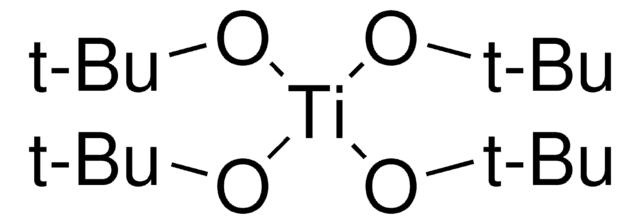Products may be shipped at a different temperature than the recommended long-term storage temperature. If the product quality is sensitive to short-term exposure to conditions other than the recommended long-term storage, it will be shipped on wet or dry-ice. If the product quality is NOT affected by short-term exposure to conditions other than the recommended long-term storage, it will be shipped at ambient temperature. As shipping routes are configured for minimum transit times, shipping at ambient temperature helps control shipping costs for our customers. For more information, please refer to the Storage and Transport Conditions document: https://www.sigmaaldrich.com/deepweb/assets/sigmaaldrich/marketing/global/documents/316/622/storage-transport-conditions-mk.pdf
205273
Titanium(IV) isopropoxide
97%
Synonym(s):
TTIP, Tetraisopropyl orthotitanate
About This Item
Recommended Products
Quality Level
Assay
97%
form
liquid
reaction suitability
core: titanium
reagent type: catalyst
refractive index
n20/D 1.464 (lit.)
bp
232 °C (lit.)
mp
14-17 °C (lit.)
density
0.96 g/mL at 20 °C (lit.)
SMILES string
CC(C)O[Ti](OC(C)C)(OC(C)C)OC(C)C
InChI
1S/4C3H7O.Ti/c4*1-3(2)4;/h4*3H,1-2H3;/q4*-1;+4
InChI key
VXUYXOFXAQZZMF-UHFFFAOYSA-N
Looking for similar products? Visit Product Comparison Guide
General description
Application
Packaging
Legal Information
Signal Word
Warning
Hazard Statements
Precautionary Statements
Hazard Classifications
Eye Irrit. 2 - Flam. Liq. 3 - STOT SE 3
Target Organs
Central nervous system
Storage Class Code
3 - Flammable liquids
WGK
WGK 1
Flash Point(F)
105.8 °F - Pensky-Martens closed cup
Flash Point(C)
41 °C - Pensky-Martens closed cup
Personal Protective Equipment
Choose from one of the most recent versions:
Already Own This Product?
Find documentation for the products that you have recently purchased in the Document Library.
Customers Also Viewed
Articles
Electrospinning technique applications discussed, emphasizing control of nanofibers and assembly into 3D architectures.
Electrospinning technique applications discussed, emphasizing control of nanofibers and assembly into 3D architectures.
Electrospinning technique applications discussed, emphasizing control of nanofibers and assembly into 3D architectures.
Electrospinning technique applications discussed, emphasizing control of nanofibers and assembly into 3D architectures.
-
How is shipping temperature determined? And how is it related to the product storage temperature?
1 answer-
Helpful?
-
-
How can I determine the shelf life / expiration / retest date of this product?
1 answer-
If this product has an expiration or retest date, it will be shown on the Certificate of Analysis (COA, CofA). If there is no retest or expiration date listed on the product's COA, we do not have suitable stability data to determine a shelf life. For these products, the only date on the COA will be the release date; a retest, expiration, or use-by-date will not be displayed.
For all products, we recommend handling per defined conditions as printed in our product literature and website product descriptions. We recommend that products should be routinely inspected by customers to ensure they perform as expected.
For products without retest or expiration dates, our standard warranty of 1 year from the date of shipment is applicable.
For more information, please refer to the Product Dating Information document: https://www.sigmaaldrich.com/deepweb/assets/sigmaaldrich/marketing/global/documents/449/386/product-dating-information-mk.pdfHelpful?
-
-
Buongiorno, utilizziamo questo reagente per determinare la presenza di acqua nei solventi acquistati. Sapreste dirmi qual è la quantità minima di acqua che è possibile rilevare?
1 answer-
While this material will react with water to form TiO2, the product is not specifically tested or used as a water scavenger. Unfortunately, there is no internal method or information available regarding this reaction. A brief search of the literature did not reveal any additional information.
Helpful?
-
-
What is the equivalent weight of ttip
1 answer-
The equivalent weight of this product can be calculated by dividing the molecular weight by the net positive valence. It has 284.22 grams of Titanium(IV) isopropoxide per mole of titanium, and 71.055 grams of Titanium(IV) isopropoxide per mole of isopropoxide. The equivalent weight would depend on the source. That is, if you are looking at the material as a source of Titanium(IV), you would use 284.22 grams. But if they are looking at it as a source of the strong base (isopropoxide ion), you would use 71.055 grams. When looking at the Titanium(IV) isopropoxide per mole of titanium, there are +4 positively charged valence electrons which resulted 71.055 for the equivalent weight.
Helpful?
-
-
What is the difference between this and 87560 ttip?
1 answer-
Products 205273 and 87560 have the same Chemical Abstract Service (CAS) number
546-68-9, which means chemically they are the same substance. The difference between the two products are the product specifications. The product specification sheets for each product are linked below to facilitate a comparison for the specific application needs.https://www.sigmaaldrich.com/specification-sheet/ALDRICH/87560
https://www.sigmaaldrich.com/specification-sheets/355/956/205273-BULK.pdfHelpful?
-
-
What is the Department of Transportation shipping information for this product?
1 answer-
Transportation information can be found in Section 14 of the product's (M)SDS.To access the shipping information for this material, use the link on the product detail page for the product.
Helpful?
-
-
What is the viscosity of Product 205273, Titanium (IV) Isopropoxide?
1 answer-
The viscosity of titanium (IV) isopropoxide is 4.5 centipoise at 25 deg C.
Helpful?
-
-
What needs to be done if Product 205273, Titanium (IV) Isopropoxide is a solid instead of a liquid?
1 answer-
The material will melt/freeze at 18-20 deg C, therefore the material can freeze when shipped during the winter months. It can be warmed in a water bath to about 30 deg C to change the state without harming the chemical.
Helpful?
-
-
What is Product 205273, Titanium (IV) Isopropoxide soluble in?
1 answer-
This chemical is very soluble in ethanol, carbon tetrachloride, hexane, benzene, or isopropanol. Water is not recommended as a solvent because titanium (IV) isopropoxide will hydrolyze. (Precautions should be taken to make sure the solvents used do not contain any water - anhydrous grades would be recommended).
Helpful?
-
Active Filters
Our team of scientists has experience in all areas of research including Life Science, Material Science, Chemical Synthesis, Chromatography, Analytical and many others.
Contact Technical Service














